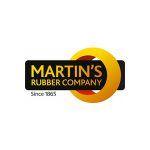Neoprene or silicone rubber sheeting
PIF spoke to Martin’s Rubber about the difference between rubber and neoprene. When it comes to understanding whether you need silicone sheets or neoprene sheets, it is important to compare the properties of both.
In this article, rubber sheeting experts Martin's Rubber explains the difference between each material and help you decipher what rubber would best suit your application. Do you need rubber or neoprene for your application? Find out here with PIF.
Discover the difference between silicone rubber and neoprene
One of the most distinguishing features that demonstrates the difference between rubber and neoprene is that silicone rubber is designed to withstand extreme temperatures, while neoprene is less suitable for these environments. Equally, silicone rubber is not designed for use around oil. Neoprene on the other hand, specialises in resisting moisture.
Silicone sheet or neoprene sheet?
We'll start with silicone. The difference between silicone rubber and neoprene is that silicone is a semi-organic synthetic material that is designed to resist extreme temperatures up to +300°C and as low as -55°C. Silicone is an excellent electrical insulator that exhibits fire resistant characteristics and thermal stability. Silicone is a soft, compressible material, which makes it popular for a range of sealing applications. Silicone sponge sheet is, however, highly inert and does not react well with chemicals, particularly oils. Although silicone is the perfect material for heat resistance, it is not suitable for dynamic applications due to its poor tear strength.
However, neoprene has been proving its performance for 75 years. It is effective for providing resistance to gasoline, sunlight, ozone and oxidation and has very good air- and water-tight sealing properties. This versatile rubber is the world's first ever synthetic oil resistant elastomer. Neoprene sponge rubber sheet is commonly used in marine environments, as well as construction and electronics industries, for weather strips, closure seals and shock/noise absorption.
Neoprene or silicone rubber sheeting - what are the differences?
The main distinguishing difference between neoprene and silicone sponge rubber sheeting is that silicone is designed to withstand extreme temperatures but is not suitable to be used around oil. Whereas, Neoprene specialises in resisting moisture but is less suitable for high temperatures. Both materials have their obvious strengths and weaknesses, which is why it is worth speaking to a rubber expert like Martin's Rubber to ensure that you select the right material for your application. They can guide you towards the best neoprene or silicone rubber sheeting material for your industry requirements.
For more information about the difference between rubber and neoprene sheeting, contact an expert at Martin's Rubber today.
Get the latest process industry news
Interested in receiving even more industry-leading news from Process Industry Forum delivered directly to your inbox? Then sign up to our free newsletter. Bringing you the latest news, trends, innovations and opinion from across the process industry, our exclusive newsletter gives you all the industry insights of the moment in one, easy-to-digest bulletin. Stay ahead of the competition with regular process industry news instalments from PIF.

